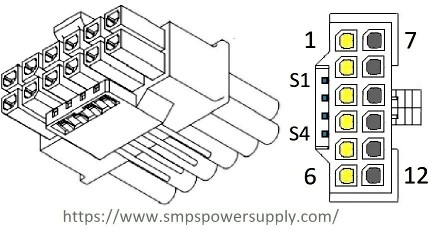ATX 3.0 POWER SUPPLY: CONNECTORS, PINOUT and SPECIFICATION
| Home | Reference | ATX3 pinout | Magnetic Units | SMPS Tutorial |
| Color Codes | Metric Conversion | Computer PSU | Calculators | ATX pinout |
Intel's ATX 3.0 power supply specification is designed to support next-generation hardware and technologies like PCIe Gen 5.0. The main change in this spec is a new auxiliary 12VHPWR connector intended for PCIe 5.0 desktop graphics cards. This new connector can provide up to 600 watts directly to a PCIe 5.0 add-in/graphics card. It also includes so-called sideband signals that will allow the power supply to communicate the power limit to a PCIe 5.0 graphic card. Here are the description and pinout of 12VHPWR connector.

Sense signals Sense0 and Sense1 (pins S3 and S4) are not for remote voltage sense as one might think. They let Add-in Card know information about PSU. A logical combination of these signals tells the Add-in Card how much power it can use according to the table below. In the PSU the appropriate SENSE signals must be pulled to ground or left open to tell the card power limits of this power supply. These signals may dynamically changed, but only when the power supply is in Standby Mode.
Optional CARD_PWR_STABLE signal is a "Power Good" signal, except it comes from Add-in Card rather than from PSU. The Add-in Card sets this signal to Open (high impedance) when its power rails are within their operating limits. When the card pulls this signal low, it indicates that any of its power rails are outside of proper limits, which resulted in a fault.
An optional CARD_CBL_PRES# signal tells PSU that an Add-in Card is detected and present. All four sideband signals can vary from 0 to 3.3V.
All other power connectors in ATX3 specification are the same as in ATX2 (see ATX connectors and pinout). Particularly, there is main 24-pin power connector, 4-pin peripheral connector, 15-pin serial ATA, and 2x2, 2x3, and 2x4 Auxiliary 12V power.
Aside from the new connector, ATX3.0 provides an important requirement for surge current. The thing is, new graphics cards may briefly draw surge power up to 3 times the continuous power level. The Intel's spec requires PSU models over 450W to be able to supply at least twice the rated power for 100μs (1.5 times if less than 450W). You can download ATX3 specification here.
| PINS |
SIGNAL |
COLOR |
| 1-6 | +12V3/V4 | YELLOW |
| 7-12 | COM | BLACK |
| S1 | CARD_PWR_STABLE | BLUE |
| S2 | CARD_CBL_PRES# | BLUE |
| S3 | SENSE0 | BLUE |
| S4 | SENSE1 | BLUE |

The pinout diagram shows front (pin side) view. The wire colors are provided just for a reference. This +12V3/V4 bus can supply up to 55A current at 12V +5%/-8%.
I will now explain the purpose of four sideband signals S1-S4.Sense signals Sense0 and Sense1 (pins S3 and S4) are not for remote voltage sense as one might think. They let Add-in Card know information about PSU. A logical combination of these signals tells the Add-in Card how much power it can use according to the table below. In the PSU the appropriate SENSE signals must be pulled to ground or left open to tell the card power limits of this power supply. These signals may dynamically changed, but only when the power supply is in Standby Mode.
| Sense0 |
Sense1 | Initial Permitted Power at System Power Up | Maximum Sustain Power after Software Configuration |
| Gnd | Gnd | 375 W | 600 W |
| Open | Gnd | 225 W | 450 W |
| Gnd | Open | 150 W | 300 W |
| Open | Open | 100 W | 150 W |
Optional CARD_PWR_STABLE signal is a "Power Good" signal, except it comes from Add-in Card rather than from PSU. The Add-in Card sets this signal to Open (high impedance) when its power rails are within their operating limits. When the card pulls this signal low, it indicates that any of its power rails are outside of proper limits, which resulted in a fault.
An optional CARD_CBL_PRES# signal tells PSU that an Add-in Card is detected and present. All four sideband signals can vary from 0 to 3.3V.
All other power connectors in ATX3 specification are the same as in ATX2 (see ATX connectors and pinout). Particularly, there is main 24-pin power connector, 4-pin peripheral connector, 15-pin serial ATA, and 2x2, 2x3, and 2x4 Auxiliary 12V power.
Aside from the new connector, ATX3.0 provides an important requirement for surge current. The thing is, new graphics cards may briefly draw surge power up to 3 times the continuous power level. The Intel's spec requires PSU models over 450W to be able to supply at least twice the rated power for 100μs (1.5 times if less than 450W). You can download ATX3 specification here.
For the operation basics of SMPS PSU see our power supply tutorial. If you want a deeper knowledge of SMPS operation get my short handbook that covers all main topologies, design topics and equations.